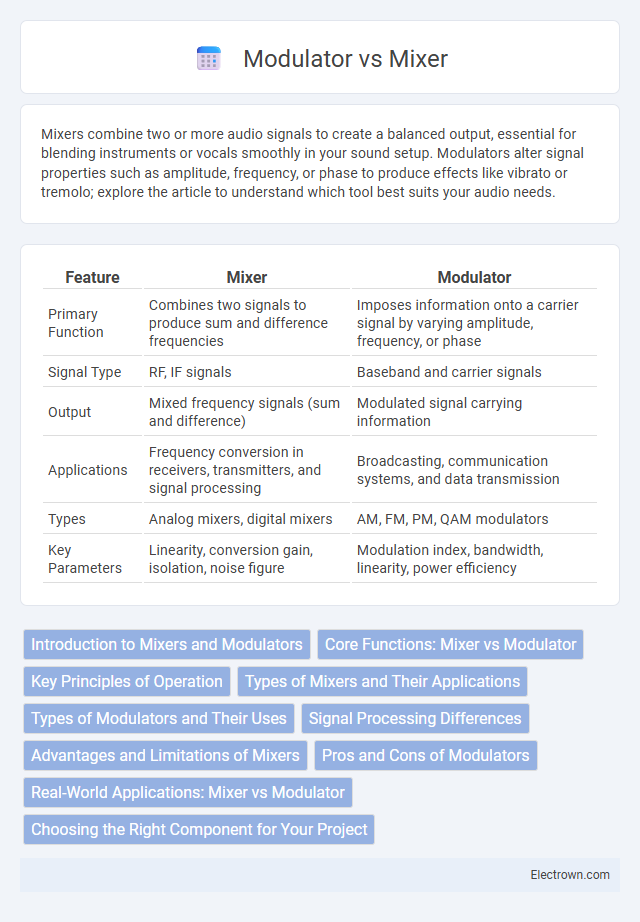Mixers combine two or more audio signals to create a balanced output, essential for blending instruments or vocals smoothly in your sound setup. Modulators alter signal properties such as amplitude, frequency, or phase to produce effects like vibrato or tremolo; explore the article to understand which tool best suits your audio needs.
Table of Comparison
| Feature | Mixer | Modulator |
|---|---|---|
| Primary Function | Combines two signals to produce sum and difference frequencies | Imposes information onto a carrier signal by varying amplitude, frequency, or phase |
| Signal Type | RF, IF signals | Baseband and carrier signals |
| Output | Mixed frequency signals (sum and difference) | Modulated signal carrying information |
| Applications | Frequency conversion in receivers, transmitters, and signal processing | Broadcasting, communication systems, and data transmission |
| Types | Analog mixers, digital mixers | AM, FM, PM, QAM modulators |
| Key Parameters | Linearity, conversion gain, isolation, noise figure | Modulation index, bandwidth, linearity, power efficiency |
Introduction to Mixers and Modulators
Mixers and modulators are essential components in signal processing and communication systems, where mixers combine two input signals to produce new frequencies typically for frequency translation, and modulators vary a carrier signal according to the information signal for transmission. Your understanding of mixers involves their role in heterodyne receivers and frequency conversion, while modulators play a crucial role in encoding information onto carrier waves through amplitude, frequency, or phase modulation. Both devices optimize signal handling, but mixers primarily focus on frequency interaction whereas modulators focus on signal encoding.
Core Functions: Mixer vs Modulator
A mixer combines two input signals, typically a radio frequency (RF) and an intermediate frequency (IF), to produce new frequencies such as the sum and difference of the original frequencies, essential in frequency translation for communication systems. A modulator, on the other hand, imposes information onto a carrier signal by varying its amplitude, frequency, or phase, enabling data transmission over various channels. Understanding these core functions helps you select the right component for signal processing or communication design tasks.
Key Principles of Operation
A mixer operates by combining two input signals to produce new frequencies through a nonlinear process, primarily generating sum and difference frequencies critical in frequency translation and signal processing. A modulator varies a carrier signal's amplitude, frequency, or phase in accordance with the information signal, enabling data transmission over communication channels. Both devices rely on specific nonlinear or control principles to manipulate signal properties for effective communication system functionality.
Types of Mixers and Their Applications
Types of mixers include diode mixers, Gilbert cell mixers, and passive double-balanced mixers, each serving unique applications from RF signal frequency conversion to image rejection in communication systems. Modulators like amplitude, frequency, and phase modulators play a crucial role in encoding information onto carrier waves for transmission in broadcast, radar, and telemetry systems. Your choice between mixers and modulators hinges on whether the goal is frequency translation or signal modulation for data communication.
Types of Modulators and Their Uses
Modulators are essential components in communication systems, with types including amplitude modulators (AM) used in AM radio broadcasting for varying signal strength, frequency modulators (FM) applied in FM radio and television for frequency variations, and phase modulators (PM) utilized in digital communication for phase shifts in carrier signals. Each type offers distinct advantages in noise resistance and bandwidth efficiency, with AM favoring simplicity and cost-effectiveness, FM providing improved sound quality and interference rejection, and PM excelling in complex modulation schemes like phase-shift keying (PSK). Understanding these modulators aids in selecting appropriate technology for applications ranging from audio transmission to data communication and radar systems.
Signal Processing Differences
Mixers and modulators differ fundamentally in signal processing functions; mixers combine two input signals to produce sum and difference frequencies, primarily used in frequency translation in communications. Modulators, however, encode information onto a carrier wave by varying its amplitude, frequency, or phase, essential for transmitting data. The mixer output contains multiple frequency components, whereas the modulator output maintains the carrier frequency's structure altered by the information signal.
Advantages and Limitations of Mixers
Mixers offer the advantage of frequency conversion, enabling the shifting of signals to desired intermediate frequencies essential in radio communication and signal processing. They provide high linearity and dynamic range, which helps in minimizing signal distortion and preserving signal integrity. However, mixers suffer from limitations such as the introduction of unwanted spurious signals and intermodulation products, which can degrade overall system performance if not properly filtered.
Pros and Cons of Modulators
Modulators offer precise control over signal amplitude, frequency, or phase, making them essential in communication systems for encoding information efficiently. Their main advantage lies in improving signal integrity and reducing interference, but they can introduce complexity and require higher power consumption compared to mixers. Understanding your system's requirements helps determine if a modulator's benefits outweigh its drawbacks for optimized performance.
Real-World Applications: Mixer vs Modulator
Mixers are essential in radio frequency (RF) systems for frequency translation, enabling receivers and transmitters to convert signals between different frequency bands for effective communication. Modulators play a critical role in encoding information onto carrier waves in applications such as digital broadcasting, satellite communication, and wireless networking. Your choice between a mixer and a modulator depends on whether the task requires signal frequency conversion or data embedding onto a carrier frequency.
Choosing the Right Component for Your Project
Choosing the right component for your project depends on whether frequency conversion or signal modulation is required; mixers are ideal for frequency translation in communication systems, while modulators encode information onto carriers. Understanding the specific application, such as RF signal processing or waveform generation, guides the decision between a mixer's nonlinear frequency mixing capabilities and a modulator's signal amplitude or phase control. Your project's performance goals and signal characteristics will determine the optimal choice between these two crucial components.
Mixer vs Modulator Infographic

 electrown.com
electrown.com